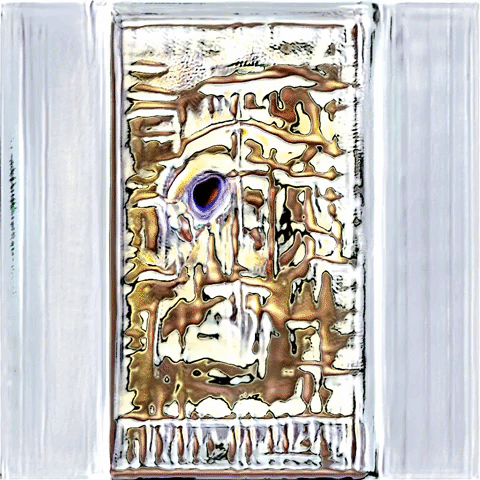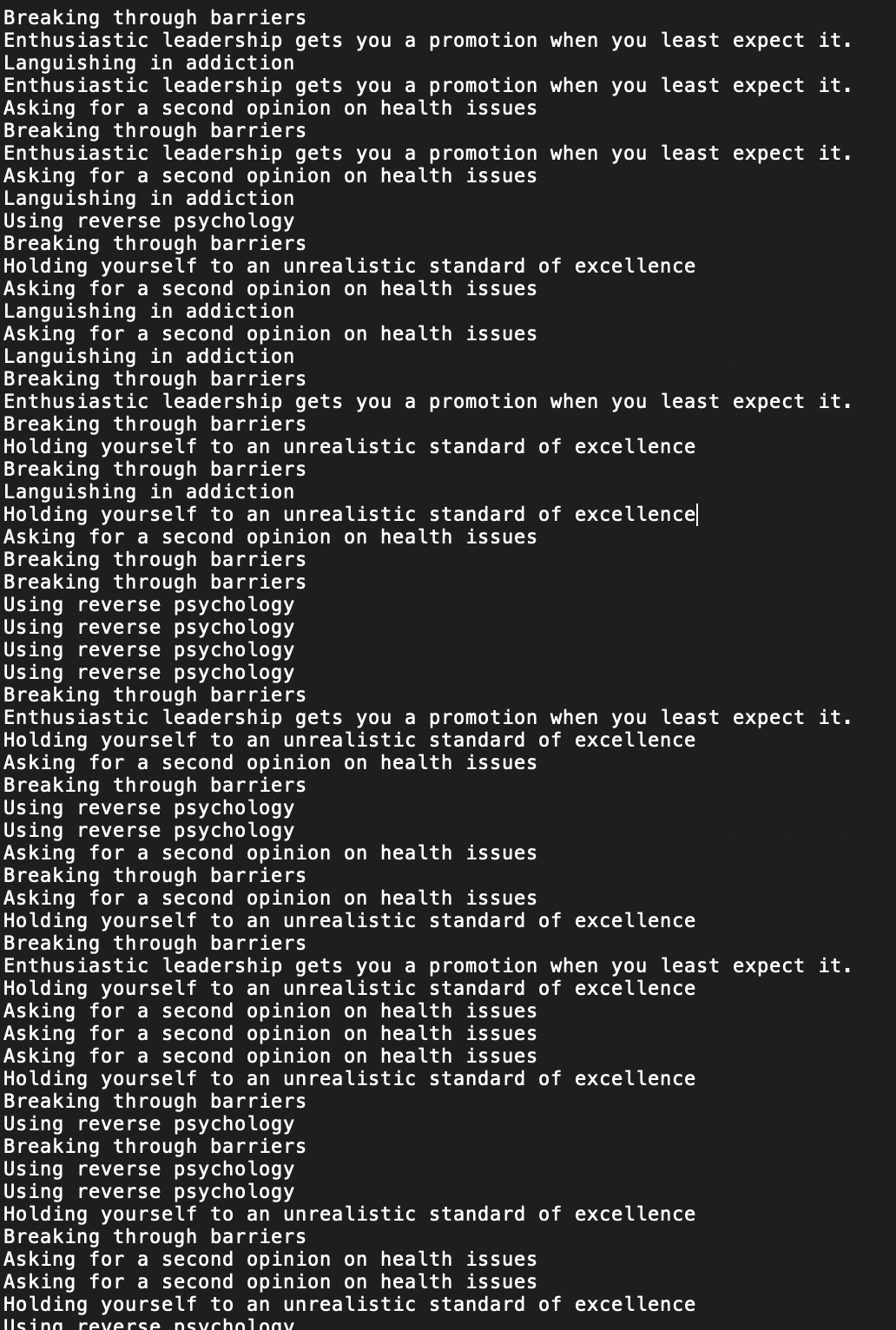Idea & Inspiration
There is a certain kind of magic in choosing through a process that seems seemingly random. Tarot cards are one example, where there is a series of cards and we try to divine meaning through cards that we choose at random. If the idea of Tarot Cards is to generate meaning through a randomized chaos, I figured that this would be a good idea to machine-generate a deck of tarot card images and their meanings. Another benefit of using Tarot Cards is the established rhythm of how the cards are drawn — they are usually portrait, a bit long in format, and the names are usually written at the bottom. They have a certain mystical atmosphere, and I was hoping that synthetic mediums would be able to make sense out of the card images that I would feed it.
Process
This project initially started out as an experiment related to my Electronic Rituals, Oracles and Fortune Telling class. However, I decided to explore further since I was starting to learn so much from this project.
For this project, I collected about 700 tarot card images from the internet (source links [1], [2], [3] and [4]) and used StyleGAN on RunwayML to train a tarot card model. Then, I compiled interpretations of readings and ran them through GPT-2 on RunwayML to generate new meanings. Finally, for the names, I settled on having a list of feelings that would pick 22 of them out of random. The number 22 comes from the major arcana of Tarot Cards. There were many pitfalls that I encountered throughout this process, I will list them below.
Attempt #1 at Training StyleGAN






Attempt #2 at Training StyleGAN







Attempt #3 at Training StyleGAN







Attempt #4 at Training StyleGAN







Attempt to Train GPT-2
In an attempt to train GPT-2 on ‘fortune-telling’ sentences, I collected data from fortune cookie message archives (link [1], [2], [3]), proverb saying collections from the internet, and Tarot reading data (from Allison Parrish). Unfortunately, it ended up only being about 167KB’s worth of text (it takes a LOT of text to be over 1MB, I realized!), and the GPT–2 ended up only repeating the data that it already had.
So in the end, I just ended up using the same dataset but just selecting random samples of meanings (instead of generating them).
Final Outcome
After being disappointed with earlier attempts, I tried to debug the dataset — meaning that I tried to have a smaller quantity of samples that are more similar to each other in terms of artistic quality and resolution. I scraped this Japanese Blog that had four editions of the Rider-Waite-Smith tarot card deck, and added in one more set that I had. It wasn’t quite 500 images, but I hoped that it would be enough. Also, I found that the StyleGAN in Runway had a second, improved version. So I tried it out.
Here is a gist of the scraping Jupyter Notebook
To my pleasant surprise, the model turned out the most successfully than I expected! It produced much more variety than the previous models, and more predictable styles with less blobs. Still not varied enough, but a bit better than the previous attempts.
Name: The Disdain
Keyword: ['Satisfaction', 'choice', 'option']
Light: Experiencing transcendent joy
Shadow: Responding to constructive criticism with defensiveness
Name: The Restless
Keyword: ['stamina', 'conclusion', 'worry']
Light: Searching for the truth
Shadow: Spending money carelessly
Name: The Shut Down
Keyword: ['collaboration', 'motivation', 'Enthusiasm']
Light: Honoring limits
Shadow: Obsessing on errors and overlooked details
Name: The Safe
Keyword: ['difference', 'skill', 'rejection']
Light: Delivering exactly what others have asked for
Shadow: Using a barbed tongue to upset others
Name: The Wooden
Keyword: ['nurturing', 'science', 'sneakiness']
Light: Letting go
Shadow: Avoiding work that needs to be done
Name: The Present
Keyword: ['disaster', 'disruption', 'certainty']
Light: Hoping for the best
Shadow: Avoiding work that needs to be done
Name: The Frozen
Keyword: ['acquisition', 'Wealth', 'attraction']
Light: Exercising authority
Shadow: Rejecting information that suggests your intuitions are misguided
Name: The Humiliated
Keyword: ['Advancement', 'reflection', 'initiation']
Light: Investing time in learning or teaching a difficult task
Shadow: Looking out for yourself while allowing harm to come to others
Name: The Calm
Keyword: ['Speed', 'cycles', 'completeness']
Light: Starting your own business
Shadow: Taking a fatalistic approach to life
Name: The Agitated
Keyword: ['charm', 'Revival', 'withdrawal']
Light: Allowing someone to use his or her own methods to get a job done
Shadow: Debilitating passion
Name: The Brave
Keyword: ['Variance', 'fantasy', 'learning']
Light: Telling jokes
Shadow: Taking unnecessary risks as a means of proving your fearlessness
Name: The Aggravated
Keyword: ['openness', 'illumination', 'revolution']
Light: Being cheered on by the crowd
Shadow: Refusing to handle stress in healthy ways
Name: The Irritated
Keyword: ['prosperity', 'Assessment', 'grace']
Light: Starting a savings plan
Shadow: Obsessing on death and dying
Name: The Invigorated
Keyword: ['wit', 'oppression', 'reversals']
Light: Receiving the perfect gift at the perfect time
Shadow: Seizing every new idea that comes your way without question
Name: The Clenched
Keyword: ['dreams', 'purity', 'destruction']
Light: Blazing your own trail
Shadow: Habitually discounting input or feedback from others
Name: The Releasing
Keyword: ['discipline', 'Union', 'cooperation']
Light: Experiencing intense joy
Shadow: Adopting a point of view and refusing to reconsider your conclusions, even when presented with refuting evidence
Name: The Weary
Keyword: ['attention', 'irrationality', 'health']
Light: Making sacrifices
Shadow: Using cheap illusions to dazzle others
Name: The Compassion
Keyword: ['assumptions', 'investigation', 'combination']
Light: Taking care of the small details
Shadow: Employing sarcasm
Name: The Itchy
Keyword: ['dissatisfaction', 'illumination', 'diplomacy']
Light: Understanding the meaning of life
Shadow: Using clever insults to undermine the confidence of others
Name: The Tight
Keyword: ['fervor', 'training', 'fulfillment']
Light: Bearing fruit
Shadow: Putting excessive emphasis on appearances
Name: The Burning
Keyword: ['overwhelming emotion', 'community', 'rejection']
Light: Picking yourself up by your own bootstraps
Shadow: Ignoring healthy approaches to life
Name: The Relaxed
Keyword: ['Authority', 'Enlightenment', 'Fertility']
Light: Winning a competition
Shadow: Torturing yourself with regrets
Final Thoughts
I’m happy with where it ended up, although I can’t get over my frustration of wanting the images to be more different and varied. It seems the data is running into the problem of overfitting, when it trains for more than 4,000 steps. If only I had more tarot cards and data!
The latent space for the last model


![Name: The DisdainKeyword: ['Satisfaction', 'choice', 'option']Light: Experiencing transcendent joyShadow: Responding to constructive criticism with defensiveness](https://images.squarespace-cdn.com/content/v1/539f1e1ee4b0ccf77812352f/1584063462120-KKZH4BS00XUZSJGYCN64/img000000004.jpg)
![Name: The RestlessKeyword: ['stamina', 'conclusion', 'worry']Light: Searching for the truthShadow: Spending money carelessly](https://images.squarespace-cdn.com/content/v1/539f1e1ee4b0ccf77812352f/1584063494028-JQRBNID6JILYXIQAINVN/img000000019.jpg)
![Name: The Shut DownKeyword: ['collaboration', 'motivation', 'Enthusiasm']Light: Honoring limitsShadow: Obsessing on errors and overlooked details](https://images.squarespace-cdn.com/content/v1/539f1e1ee4b0ccf77812352f/1584063572849-XGW3HDV9FGYYCJODOAPY/img000000032.jpg)
![Name: The SafeKeyword: ['difference', 'skill', 'rejection']Light: Delivering exactly what others have asked forShadow: Using a barbed tongue to upset others](https://images.squarespace-cdn.com/content/v1/539f1e1ee4b0ccf77812352f/1584063599609-RDGTV5AGSXQE202QKLQ2/img000000098.jpg)
![Name: The WoodenKeyword: ['nurturing', 'science', 'sneakiness']Light: Letting goShadow: Avoiding work that needs to be done](https://images.squarespace-cdn.com/content/v1/539f1e1ee4b0ccf77812352f/1584063624691-L0O1MXZWNYCVM2FV6RD4/img000000087.jpg)
![Name: The PresentKeyword: ['disaster', 'disruption', 'certainty']Light: Hoping for the bestShadow: Avoiding work that needs to be done](https://images.squarespace-cdn.com/content/v1/539f1e1ee4b0ccf77812352f/1584063648943-A7S898D6VP1SA3LV5LIN/img000000099.jpg)
![Name: The FrozenKeyword: ['acquisition', 'Wealth', 'attraction']Light: Exercising authorityShadow: Rejecting information that suggests your intuitions are misguided](https://images.squarespace-cdn.com/content/v1/539f1e1ee4b0ccf77812352f/1584063673305-XWOMLIEHAK0AL3J248MU/img000000041.jpg)
![Name: The HumiliatedKeyword: ['Advancement', 'reflection', 'initiation']Light: Investing time in learning or teaching a difficult taskShadow: Looking out for yourself while allowing harm to come to others](https://images.squarespace-cdn.com/content/v1/539f1e1ee4b0ccf77812352f/1584063694051-V7ILH4ZYRAK8LW1FR37Z/img000000090.jpg)
![Name: The CalmKeyword: ['Speed', 'cycles', 'completeness']Light: Starting your own businessShadow: Taking a fatalistic approach to life](https://images.squarespace-cdn.com/content/v1/539f1e1ee4b0ccf77812352f/1584063722690-Y6GZ52RQAX8A73SMAYZY/img000000083.jpg)
![Name: The AgitatedKeyword: ['charm', 'Revival', 'withdrawal']Light: Allowing someone to use his or her own methods to get a job doneShadow: Debilitating passion](https://images.squarespace-cdn.com/content/v1/539f1e1ee4b0ccf77812352f/1584063763617-ZX0ISEHTH8GU37SDRHGT/img000000011.jpg)
![Name: The BraveKeyword: ['Variance', 'fantasy', 'learning']Light: Telling jokesShadow: Taking unnecessary risks as a means of proving your fearlessness](https://images.squarespace-cdn.com/content/v1/539f1e1ee4b0ccf77812352f/1584063840565-5VLNBGWY6VQ13UYYBUJV/img000000000.jpg)
![Name: The AggravatedKeyword: ['openness', 'illumination', 'revolution']Light: Being cheered on by the crowdShadow: Refusing to handle stress in healthy ways](https://images.squarespace-cdn.com/content/v1/539f1e1ee4b0ccf77812352f/1584063872825-LZAM7MGJCJQV20PL1I36/img000000076.jpg)
![Name: The IrritatedKeyword: ['prosperity', 'Assessment', 'grace']Light: Starting a savings planShadow: Obsessing on death and dying](https://images.squarespace-cdn.com/content/v1/539f1e1ee4b0ccf77812352f/1584063897554-PRC8JLAOQAEF0NPR6C5X/img000000069.jpg)
![Name: The InvigoratedKeyword: ['wit', 'oppression', 'reversals']Light: Receiving the perfect gift at the perfect timeShadow: Seizing every new idea that comes your way without question](https://images.squarespace-cdn.com/content/v1/539f1e1ee4b0ccf77812352f/1584063917820-S39AB3AFN08KB0WE89BU/img000000036.jpg)
![Name: The ClenchedKeyword: ['dreams', 'purity', 'destruction']Light: Blazing your own trailShadow: Habitually discounting input or feedback from others](https://images.squarespace-cdn.com/content/v1/539f1e1ee4b0ccf77812352f/1584063939602-UJFUEVG6NEBQHZJ9HC2V/img000000044.jpg)
![Name: The ReleasingKeyword: ['discipline', 'Union', 'cooperation']Light: Experiencing intense joyShadow: Adopting a point of view and refusing to reconsider your conclusions, even when presented with refuting evidence](https://images.squarespace-cdn.com/content/v1/539f1e1ee4b0ccf77812352f/1584063966231-TVL748BHGT0GYX4EQXV0/img000000057.jpg)
![Name: The WearyKeyword: ['attention', 'irrationality', 'health']Light: Making sacrificesShadow: Using cheap illusions to dazzle others](https://images.squarespace-cdn.com/content/v1/539f1e1ee4b0ccf77812352f/1584063987417-K55K6AN1ZUCQA22X7MBW/img000000093.jpg)
![Name: The CompassionKeyword: ['assumptions', 'investigation', 'combination']Light: Taking care of the small detailsShadow: Employing sarcasm](https://images.squarespace-cdn.com/content/v1/539f1e1ee4b0ccf77812352f/1584064007105-TCNHQ26TQNCDAVWQS1UM/img000000018.jpg)
![Name: The ItchyKeyword: ['dissatisfaction', 'illumination', 'diplomacy']Light: Understanding the meaning of lifeShadow: Using clever insults to undermine the confidence of others](https://images.squarespace-cdn.com/content/v1/539f1e1ee4b0ccf77812352f/1584064058734-Q4NT9JD0JS3SQQ78N5HJ/img000000022.jpg)
![Name: The TightKeyword: ['fervor', 'training', 'fulfillment']Light: Bearing fruitShadow: Putting excessive emphasis on appearances](https://images.squarespace-cdn.com/content/v1/539f1e1ee4b0ccf77812352f/1584064077144-MPGH4J4ODW6TP5IJWPO4/img000000049.jpg)
![Name: The BurningKeyword: ['overwhelming emotion', 'community', 'rejection']Light: Picking yourself up by your own bootstrapsShadow: Ignoring healthy approaches to life](https://images.squarespace-cdn.com/content/v1/539f1e1ee4b0ccf77812352f/1584064098177-9EWBBAOX35Y1BDY01Z67/img000000077.jpg)
![Name: The RelaxedKeyword: ['Authority', 'Enlightenment', 'Fertility']Light: Winning a competitionShadow: Torturing yourself with regrets](https://images.squarespace-cdn.com/content/v1/539f1e1ee4b0ccf77812352f/1584064119818-S1BBE4MWNCQSAIPUONMQ/img000000073.jpg)
